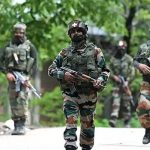

![]()
CLAWS (New Delhi) – Bangladesh Institute of Peace and Security Studies (BIPSS) (Bangladesh)
Key Challenges of Radicalisation: Perspective from Bangladesh
By Shafqat Munir, Head of Bangladesh Centre for Terrorism Research at the Bangladesh Institute of Peace and Security Studies (BIPSS).
Key Words: Radicalisation, Female, Cyber, Strategy, Countering Violent Extremism
Introduction
Radicalisation has emerged as a significant challenge across the South Asian region over the past decade. While countries have managed to find more effective ways of combating terrorism, countering radicalisation has proven to be a gargantuan challenge. As radicalisation is fueled by an ideology, unlike other, more physical manifestations of violence, radicalisation cannot be countered only by kinetic measures. Bangladesh has experienced several terrorist attacks in the past half a decade. The country has come a long way since the attack on Holey Artisan Bakery on 1 July 2016 in which many lives were lost. Due to a number of adroit operational and strategic measures, Bangladesh has managed to reduce the number of terrorist attacks in the preceding few years [1]. However, radicalisation remains a serious challenge especially among the youth, women and particularly in the cyber domain.
Targeting the Future: Youth Radicalisation
The attack on Holey Artisan Bakery is an instance where youth were radicalised to perform violent extremist acts. This attack shifted the paradigm of terrorism in Bangladesh, revealing a new set of targets vulnerable to radicalisation. It was found that youth of any educational and socio-economic background could be a prime target of radicalisation. 5 young people were responsible for the massacre at the Holey Artisan café on 1 July 2016 which led to 29 deaths (18 foreigners, 2 locals, 2 police officers, 5 gunmen, and 2 bakery staff) and many of them were educated abroad and represented the urban youth [2]. This new development broke all the previous, rather stereotypical, traits of terrorists; for instance, the notion that only Madrasa educated youth are vulnerable to becoming terrorists. Therefore, there is a need to revisit the threat of radicalisation with a new prism. There are several reasons for terrorists to displaying increased interest in enlisting the youths. Young people with no prior police records are the most attractive targets as they provide the required operational freedom to the terror outfits. Operational freedom results in the reduction in the likelihood of arrest of the more senior leaders. Youths are also a key target for their contributions in terms of additional skills. People at a young age, with a malleable view of the world and lesser idea about the society and religion, can be influenced by an ideology more, especially when they are made to feel related to people, they have a commonality with, who are suffering or being deprived of their rights. This makes them strongly react to a sense of belongingness and relative deprivation, making vulnerable to radicalization. Their views on society, religion, as well as their impression of their own standing in life and psychological constitution can make a big difference to terrorists targeting them, making them optimum for radicalization.
The several reasons behind the process of radicalisation can mount to a long list, but they can be categorized into economic, political, religious, and cultural processes. Psychological reasons play a significant role as well. Frustration in personal life, social change, oppression of expression, lack of cultural direction, lack of awareness, no anti-militancy write up in school textbooks, militant companion, no advocacy about harm of militancy, arms business, economic recession, foreign power and lack of ideology constitute other factors that may drive youth to radicalisation [3].
The Threat of Female Radicalisation
Female radicalisation has become a recent, but prominent phenomenon in Bangladesh, as within the rest of the world. What was said previously that Terrorism has a gender; that is, male; has become an obsolete notion, as we see the rise of Jihadist Feminism now. The role of women jihadism in Bangladesh has evolved from more sedentary roles, like being wives of jihadists and raising their future generations, to more prominent, active roles, including increasing participation in combat activities and facilitation of transmission of operational details, contribution to social media, as well as recruitment and mentoring of other members to terrorist groups, both male and female. Other than that, at the strategic level, female attackers are used to gaining more publicity and media attention, due to the greater psychological impact they generate on the adversary or the target audience. Furthermore, as they do not conform to any profile that would trigger law enforcement attention, their radicalisation is less noticed by people in their social surroundings.
According to Professor Mia Bloom, there are five key driving forces behind female radicalisation: revenge, redemption/ restoration, relationship and respect, and lastly, rape [4]. Apart from these, the patriarchal family structure is a core element that pushes females to radicalisation. In the case of Bangladesh, often the women find themselves encouraged, or even forced at times by the male heads of the family.
The case of Momena Shoma, a Bangladeshi student who struck her tenant in Melbourne, Australia, in 2018 merits particular attention. She had been radicalised by online radical content and had the intention of killing someone when she goes abroad [8]. There are a number of other cases of a similar nature and also instances where women were compelled to join in the path of violent extremism by their partners and peers. However, the number of women taking part in such actions voluntarily has increased and seems to be the new trend. Women are increasingly motivated by a sense of sisterhood and empowerment and as some have argued a sense of Jihadist Feminism.
The Virtual Battle of Good and Evil: Cyber Radicalisation
The number of people using the internet is increasing. As terrorist groups constantly come under attack in the real world, the virtual world has become a place for them to retreat, regroup and counter-attack. There is an urgent need to increase awareness among the youth in cyberspace and to develop better cyber hygiene [9]. While it is important to monitor cyberspace, it can be an important way to create more awareness. As the terrorists are using cyberspace, cyberspace must be dedicated for Countering Violent Extremism (CVE) and Preventing Violent Extremism (PVE) efforts [10]. Efforts such as the “Christchurch Call,” are a very welcome initiative and there needs to be more collaboration between tech companies and the government in countering radicalisation online. While we talk about online radicalisation, we must also pay attention to the spread of disinformation and fake news on the internet. There are already examples of extremist organizations to spread disinformation, spread hatred and create discord between communities.
The increasingly “tech-savvy” nature of militant groups in Bangladesh poses a renewed threat as their ability to adroitly use technology acts as a force multiplier for such groups. Although internet penetration nation-wide is still low (only 13.20 percent, as of 2016), the number of internet users in Bangladesh is growing very rapidly. There is also a growing population which accesses the Internet essentially through their phones and are sometimes not adequately represented in Internet penetration statistics. An increasing number of online discussion groups and social media outlets, whether inside Bangladesh or outside, are centered on “defending Islam against Western aggression.” [11]. A significant amount of radicalisation now takes place in what can be termed as the “online-offline combine”. A combination of targeted messaging in the virtual world followed by recruitment through interaction in the real world takes many impressionable youths towards the path of terrorism.
Concluding Remarks
As terrorist violence from Islamist militants spread across the world, the increased emphasis of terror outfits in South Asia has led to a renewed challenge in Bangladesh. Radical ideologies are being spread through various mediums, and states, including Bangladesh, have identified various symptoms unique to themselves, and yet common to all. The key challenges of radicalisation, while many, are the most prominent in terms of the three prior mentioned categories in the case of Bangladesh. It should be noted that the trends are persistent worldwide, and yet bear a unique significance to the country, as it bears to other states in their own ways.
As Fareed Zakaria said: “The ultimate counter-terrorism tool is social resilience; if we are not terrorized, they do not win.”Strengthening social resilience is, therefore, an important tool in countering radicalisation in all its forms, targeting all types of people. Other than that, while a combination of deterrence and dissuasion continues in the online realm, a proper narrative needs to be crafted in the offline realm. As we know that only a better idea can erase a former idea, meaning that to counter the online and offline narratives of the terrorist organisations, we need a better, stronger set of counter-narratives. Hence, it is important to have a solid partnership between the government and civil society, to craft the proper narratives that help counter radical threats to the country [12]. We also need to focus on de-radicalisation efforts by providing more effective narratives along with inclusion of all the stake holders for this evil. Countering terrorism in its operational manifestation is only half the challenge. The bigger more complex challenge is countering radicalisation.
The Spreading Tentacles of Radicalisation: Perspective from India
By: Anashwara Ashok, Research Assistant at Centre For Land Warfare Studies, New Delhi, India
Keywords: Radicalisation, De-radicalisation, Counter-radicalisation, Terrorism, Jammu and Kashmir, West and South India, Homegrown Terrorism
Another decade ended with the world still confronting the scourge of terrorism. The 2019 edition of the Global Terrorism Index though records a decline in the number of deaths caused by terrorist attacks but also claims an increase in the number of countries affected by terrorism[1]. The Indian subcontinent witnessed two deadly terror attacks that captured the world’s attention in 2019. An attack on the convoy of India’s paramilitary forces in Pulwama in February and a series of coordinated explosions in Sri Lankan churches and hotels in April. A close look at the modus operandi of these attacks reveals the involvement of local or ‘homegrown’ terrorists.
The phenomenon of radicalisation has notoriously impacted the Indian society in the recent past and there is an imminent need to tackle this challenge.
Radicalisation and ‘Homegrown’ Terrorism
India is not new to the phenomenon of radicalisation and ‘homegrown’ terrorism. The country has been facing different aspects of it since the 1970s at different levels, be it terrorism in Jammu and Kashmir (J&K), Punjab or North-eastern states.
Jammu and Kashmir: India in 2000 witnessed the fatal effect of radicalisation when a local radicalised Kashmiri teenager tried attacking the Indian Army’s 15 Corps Headquarters at the Badami Bagh cantonment in Srinagar[2]. Another case in point of ‘homegrown terrorism’ is the Pulwama terror attack of 14 February 2019, killing over 40 Indian paramilitary personnel in Jammu and Kashmir. The perpetrator of this deadly terror attack, Adil Ahmed Dar, was a young Kashmiri youth who got radicalised by nefarious forces from across the border. This is an archetypal case of radicalisation in Kashmir. Factors such as prolonged violence for over thirty years; lack of economic development; mis-governance; and alienation from the rest of the country due to separate legislation (now abrogated Article 370 and Article 35A) have raised grievances in the minds of people in the Kashmir Valley which lowered their hopes for a better future which is at par with the rest of the country. Such grievances have been exploited by Pakistan from time to time in order to radicalise the Kashmiris to the extent of instigating them to join terrorism. It has been noted that cross-border propaganda in the form of exporting into Kashmir radical religious thought (Salafism/Wahhabism) that replaced the traditional Sufi Islam in the area, has been one of the primary reasons for the growing radicalisation in the Valley. This has resulted in the growth of religious institutions; leaders; preachers and madrasas, mostly funded from across the border. These have been promoting an anti-India narrative through extremist literature, doctored images and videos and social medial platforms. Such tactics are used specifically on vulnerable and disenchanted minds such as Adil Ahmed Dar, to the extent that they tend to join terrorist organisations and carry out attacks against the security personnel and innocent civilians. Indeed, in the post-internet phase, Kashmir has witnessed a major surge in local militants with around 191 local youths joining militancy in 2018[3]. Since, the heavy presence of armed forces along with fencing across the LoC has restricted infiltration of militants from Pakistan, hence, social media has become the new tool for not only indoctrination but also recruitment of locals into terror outfits, creating in Kashmir “the new breed of militants- young, educated and tech-savvy.”[4]
West and South India: Having proliferated in Jammu and Kashmir since 1990s, the phenomenon of radicalisation has today spread to newer avenues in the country, particularly to the states of West and South India. With the rise of Islamic State (IS) in 2014 in the Middle East, several cases of Indian operatives and sympathisers of IS came to light. In June 2019, the Minister of State for Home Affairs in the Indian Parliament stated that central and state security agencies had in total recorded around 155 IS members/sympathisers in India, many being from these states.[5] Terror groups such as Students Islamic Movement of India (SIMI) and Indian Mujahideen (IM) have operated extensively in these states. Notably, all these groups use the common factor of religious ideology to radicalise the vulnerable minds following which many of them get recruited into the organisation to carry out attacks on fellow citizens. Such radicalisation has been further stimulated by ultra-puritanical Salafist organisations like Nadwatul Mujahideen (Kerala), Tauheed Jamat (Tamil Nadu), Peace Educational Foundation (Kerala) and Discover Islam Education Trust (Bengaluru)[6].
An instance of growing radicalisation in South Indian states can be seen in the spate of raids and arrests made in the region immediately after the Easter bomb attacks on 21 April 2019, in Sri Lanka. Investigators suspect that some of the perpetrators were indoctrinated, radicalised and trained in the Indian state of Tamil Nadu[7]. Further probe found that Zahran Hashim, the mastermind of the attacks, had travelled to India and also maintained virtual links with radicalised youth in South India. Moreover, while claiming responsibility for the attacks, IS issued statements not only in English and Arabic but even in South India languages-Malayalam and Tamil[8]. This shows that there exist individuals in the region affiliated to IS and there also exist individuals fluent in these South Indian languages within the rank and file of the IS.
However, the process of radicalisation that prevails in Jammu and Kashmir, apart from few similarities, is different from the kind of radicalisation that has dawned upon the states of Kerala, Karnataka, Tamil Nadu, Andhra Pradesh, Maharashtra, Telangana and Gujarat. Both the cases have witnessed well-orchestrated online radicalisation. Internet and social media has been widely used for propagating extremist ideologies and radicalising the vulnerable minds into becoming terrorists. Also, role of hard-line Salafi/Wahhabi ideology propagated by the extremist Islamic clerics and institutions like madrasas, resulting in radical religious indoctrination is another similarity that can be drawn in these cases. It is also pertinent to note that radicalisation in Jammu and Kashmir can be directly linked to the proxy-war sponsored by Pakistan, while the one witnessed in West and South India is largely a response to the growing spread of IS ideology, promoting the rule of Sharia and Caliphate-based system. As a result, many radicalised local Kashmiris join Pakistan-backed terror groups with the desire to fight for the fractured idea of ‘Azadi’ or other localised issues. But in cases of radicalised people in West and South India, role of Global Jihad seems prominent as most of the arrested people were en route to Syria and Iraq to join IS like the group of 22 people from the same family in Kerala having reportedly travelled in June 2016 to Afghanistan via Iran to join the IS[9]. It is common in all these cases that people were indoctrinated by the motivation to migrate from Dar-ul-Harb (house of war) to Dar-ul-Islam (house of peace/Islam/Deen). A significant factor is also the diaspora of these states, particularly Kerala and Tamil Nadu, who live in the Gulf countries. Some of the Indian Muslims who have migrated to the Gulf countries have either themselves come under the influence of the ultra-conservative forms of Islam or in many cases the remittances sent by them has been utilised for spreading the radical thoughts.
On looking at the number of cases of local militants found in Jammu and Kashmir and IS sympathisers in West and South India, it can be delineated that the menace of radicalisation is widespread in Jammu and Kashmir due to the continuing logistical and financial support of Pakistan. Home to the third largest Muslim population, the recorded figures of terror sympathisers from all over India, particularly West and South India, is miniscule in comparison to the western countries. This can be attributed to various factors including religious and cultural pluralism; traditionally practiced moderate Islamic belief-systems; progressive educational and economic standards; equal socio-economic and political safeguards for the Indian Muslims enshrined in the Indian Constitution.
Tackling the Growing Threat
India has taken some steps towards de-radicalisation and counter-radicalisation in the form of the Counter-Terrorism and Counter-Radicalisation Division (CT-CR) under the Ministry of Home Affairs to help state governments, security agencies and communities in preventing the youth from embracing extremism. Also, some states like Kerala, Maharashtra and Telangana have their models of de-radicalisation programmes, functioning at the nascent stage. At the national level, India must develop a comprehensive policy that focuses both on de-radicalisation and counter-radicalisation and works in tandem with the peculiarities of each state. All such policies must give primacy to building counter-narratives that would help in managing social media propaganda of Pakistan as well as the extremists. Family members, senior citizens, civil society organisations must be roped in to monitor suspicious online activities of children and help them to overcome it and bring them back into the mainstream. With an effective content-based online regulation, blocking of websites and removing extremist propaganda, the government must launch both online and offline campaigns targeting the right audience.
Conclusion
Radicalisation is today spreading to different parts of the country as a complex phenomenon, seeking to polarise our diverse society. Despite many similarities in the factors leading to radicalisation, at times these become contextual in every state. Nevertheless, it poses a significant threat to India’s national security and needs to be tackled with robust preventive and curative policies. While formulating, it must be ensured that these are innovative and relevant as well as all-inclusive, hence, making the government, educational institutions, civil society organisations, media and the intelligentsia major stakeholders in the implementation process.
References:
[1] Institute For Economics & Peace, Global Terrorism Index 2019: Measuring the Impact of Terrorism (Sydney, November 2019). Available at http://economicsandpeace.org/reports/
[2] Harinder Baweja, “Portrait Of A Suicide-Bomber” Outlook India, 31 December 2001. Available at https://www.outlookindia.com/magazine/story/portrait-of-a-suicide-bomber/214191
[3] PTI, “191 Kashmiri youths joined militancy in 2018: Official”, The Economic Times, 4 February 2019. Available at https://economictimes.indiatimes.com/news/defence/191-kashmiri-youths-joined-militancy-in-2018-official/articleshow/67835737.cms?from=mdr
[4] Jason Burke, “Kashmir Conflict Ebbs as New Wave of Militant Emerges”, The Guardian, 11 August 2013. Available at https://www.theguardian.com/world/2013/aug/11/kashmir-conflict-new-wave-militants
[5] Government of India, Ministry of Home Affairs, Unstarred Question No. 526, (Lok Sabha: 25 June 2019). Available at https://mha.gov.in/MHA1/Par2017/pdfs/par2019-pdfs/ls-25062019/526.pdf
[6] Ghulam Rasool Dehlvi, “South India’s radicalised youths are joining ‘Jihad-e-Kashmir’” Sunday Guardian, 17 March 2018. Available at https://www.sundayguardianlive.com/news/13091-south-india-s-radicalised-youths-are-joining-jihad-e-kashmir
[7] Meera Srinivasan and Suhasini Haider, “Sri Lanka Easter blasts: Suspected mastermind Zahran Hashim spent time in south India, says top military source” The Hindu, 27 April 2019. Available at https://www.thehindu.com/news/international/sri-lanka-easter-blasts-suspected-mastermind-zahran-hashim-spent-time-in-south-india-says-top-military-source/article26959549.ece
[8] Jasminder Singh, “South India: The Islamist Connection” RSIS, 13 August 2019. Available at https://www.rsis.edu.sg/rsis-publication/icpvtr/south-india-the-islamist-connection/#.XhQW10czY2w
[9] Anurag Sharma, “Counter-Terrorism Framework of the United Nations and India’s Approach of De-Radicalisation” VIF, 26 September 2019. Available at https://www.vifindia.org/article/2019/september/26/counter-terrorism-framework-of-the-united-nations-and-india-s-approach-of-de-radicalisation.













